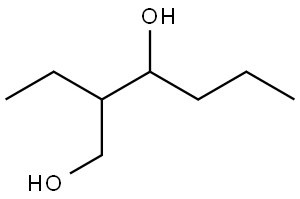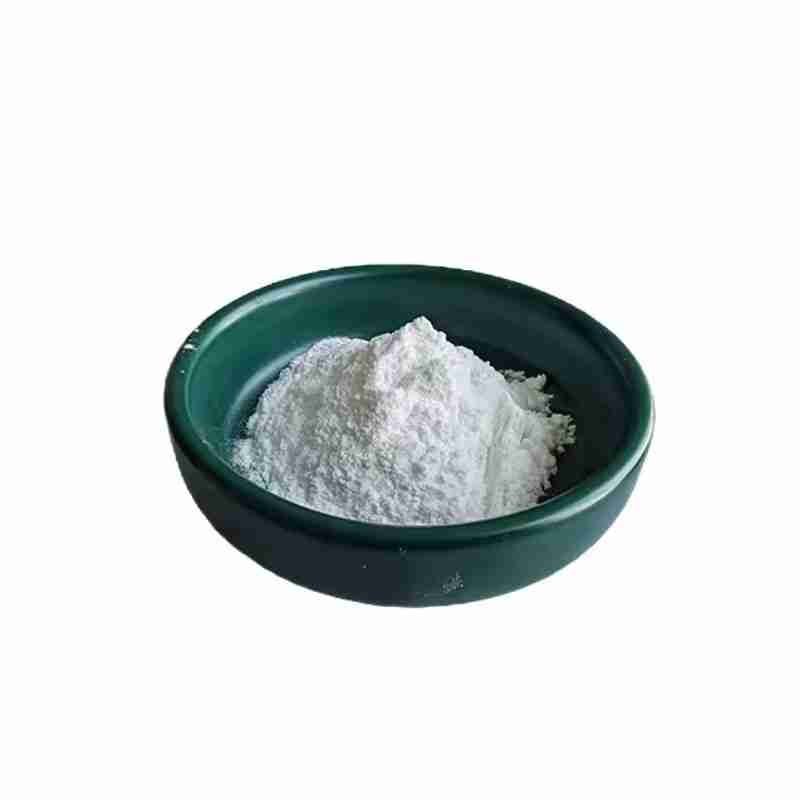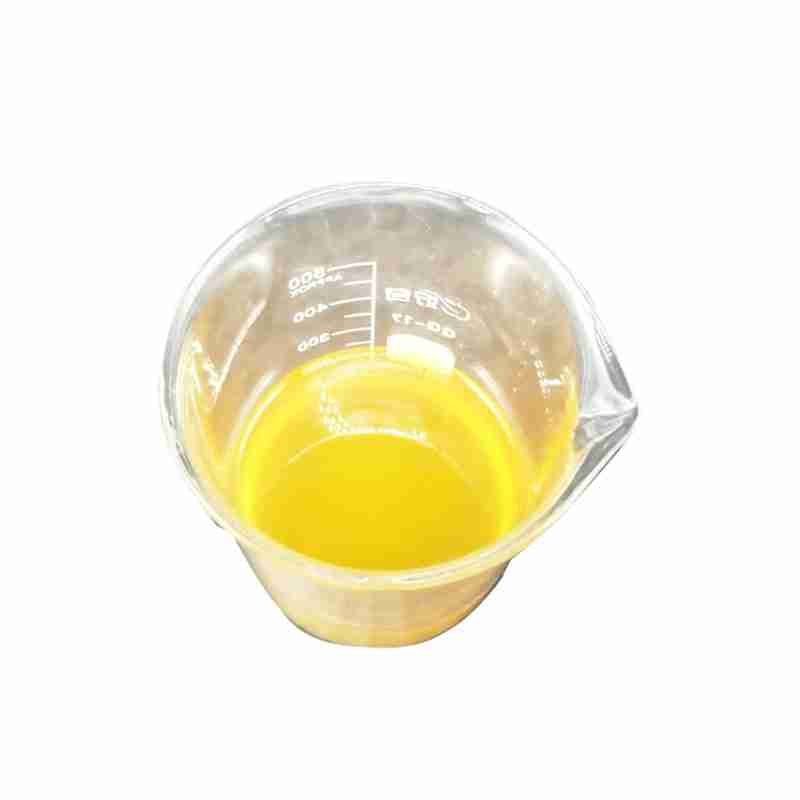2-Ethyl-1,3-hexanediol CAS #94-96-2
2-Ethyl-1,3-hexanediol is a colorless viscous liquid used as a plasticizer in the plastics and resin industry. It is also used in ink formulation to increase the permeability of ink on paper.
First, butyraldehyde is synthesized from propylene. Under the catalysis of alkali or acid, butyraldehyde self-condenses to generate 2-ethyl-3-hydroxyhexanal. This compound is very unstable and can be obtained by hydrogenation to obtain 2-ethyl-1,3-hexanediol.
发送询盘
2-Ethyl-1,3-hexanediol CAS #94-96-2
| 2-Ethyl-1,3-hexanediol Basic information |
| Product Name: | 2-Ethyl-1,3-hexanediol |
| Synonyms: | OCTYLENE GLYCOL(R);RUTGERS 612(R);2-ethyl-1,3-hexyleneglycol;2-Ethyl-2-propyl-1,3-propanediol;ETHOHEXADIOL(R);ETHOHEXADIOL(TM);2-Ethyl
hexanediol;2-ethyl-1,3-hexanediol,mixtureofisomers |
| CAS: | 94-96-2 |
| MF: | C8H18O2 |
| MW: | 146.23 |
| EINECS: | 202-377-9 |
| Product Categories: | Building Blocks;Chemical Synthesis;Organic Building Blocks;Oxygen Compounds;Polyols |
| Mol File: | 94-96-2.mol |
 |
|
| 2-Ethyl-1,3-hexanediol Chemical Properties |
| Melting point | -40 ??C (lit.) |
| Boiling point | 241-249 ??C (lit.) |
| density | 0.933 g/mL at 25 ??C (lit.) |
| vapor density | 5 (vs air) |
| vapor pressure | <0.01 hPa (20 ??C) |
| refractive index | n20/D?1.451(lit.) |
| Fp | 265???F |
| storage temp. | Store below +30??C. |
| solubility | 42g/l |
| form | Liquid |
| pka | 14.85??0.10(Predicted) |
| color | Clear |
| Odor | at 100.00?%. odorless |
| Water Solubility | 42 g/L (20 oC) |
| Sensitive | Hygroscopic |
| Merck | 14,3744 |
| BRN | 1735324 |
| Dielectric constant | 15.24 |
| LogP | 3.63 at 20?? |
| CAS DataBase Reference | 94-96-2(CAS DataBase Reference) |
| NIST Chemistry Reference | 1,3-Hexanediol, 2-ethyl-(94-96-2) |
| EPA Substance Registry System | 2-Ethyl-1,3-hexanediol (94-96-2) |
| Safety Information |
| Hazard Codes | Xi |
| Risk Statements | 41 |
| Safety Statements | 25-26-39-46 |
| WGK Germany | 1 |
| RTECS | MO2625000 |
| Autoignition Temperature | 340 ??C DIN 51794 |
| TSCA | Yes |
| HS Code | 29053980 |
| Hazardous Substances Data | 94-96-2(Hazardous Substances Data) |
| Toxicity | LD50 in male, female rats (ml/kg): 9.85, 4.92 orally (Ballantyne) |
- 2
- 2-diallylpent-4-en-1-amine
- 4
- 95-16-9
- Ammonium sulfamate
- Benzothiazole
- cas:67889-00-3ح2
- cas:83524-75-8 | pigment black 32
- cas:928836-00-4 | 2
- cas:932745-70-5 | 4
- Chemical Minerals
- Coconut diethanolamide
- Daily Chemicals
- discount
- for sale
- General pvc resin
- hexyl D-glucoside
- in stock
- Lauramidopropyl betaine
- LAURIC ACID MONOETHANOLAMIDE
- Petroleum Additives
- Plasticiser
- Ploymers
- price
- PVC
- quotation
- Raw Materal
- Remove term: Petroleum Additives Petroleum Additive
- SODIUM ETHYL 2-SULFOLAURATE
Related Products
POLY(VINYL CHLORIDE-CO-ISOBUTYL VINYL ETHER) is a copolymer that combines the properties of vinyl chloride and isobutyl vinyl ether. This polymer offers a balance of rigidity and flexibility, along with enhanced chemical resistance and durability. It is commonly used in the production of films, coatings, and adhesives due to its excellent barrier properties against gases and moisture, making it ideal for packaging and construction applications.
1-Octanol, also known as Capryl alcohol or n-Octanol, is a clear, colorless liquid with a characteristic waxy odor. It is an alcohol with eight carbon atoms in its chain, making it a part of the aliphatic alcohol family. This compound is poorly soluble in water but is miscible with ethanol, diethyl ether, and chloroform . It has a melting point of approximately -15??C and a boiling point of around 196??C . 1-Octanol is used in the production of esters, plasticizers, and as a solvent or intermediate in the synthesis of various organic compounds. It also finds application in the fragrance industry as a fixative in perfumes and can be used in the formulation of flavor and scent compositions . It is important to note that 1-Octanol is flammable and should be handled with care, storing it away from sources of ignition and heat .
Chemical Name: Choline salicylate
CAS No.: 2016-36-6
Molecular Formula: C12H19NO4
Molecular Weight: 241.28
Appearance: Red-Brown Crystal
Chemical Name: STODDARD SOLVENT
CAS No.: 64742-88-7
Appearance: Colorless or Light Yellow Liquid
Common English name: 5-iodo-2,3-dihydropyridazin-3-one
CAS No.: 825633-94-1
Molecular formula: C4H3IN2O
Molecular weight: 221.98
Sample: Available
Chemical Name: 1,1,2,2-Tetrachloroethane
Other Name: Tetrachlorethane
CAS No.: 79-34-5
Molecular Formula: C2H2Cl4
Molecular Weight: 167.85
Appearance: Liquid
Chemical Name: Imazalil Sulfate
CAS No.: 58594-72-2
Molecular Formula: C14H14Cl2N2O.H2SO4
Molecular Weight: 395.26
Appearance: Solid
Octocrylene is an organic compound widely recognized for its potent UV-filtering properties, making it an essential ingredient in sunscreens and other skincare products designed to protect the skin from harmful ultraviolet radiation. With the chemical name 2-(4-Methylbenzyl)-2H-benzotriazole-5-methyl, octocrylene is a stable and photostable molecule that provides broad-spectrum protection against both UVA and UVB rays.
This oil-soluble chemical is valued for its ability to absorb UV radiation effectively, converting it into heat without causing skin irritation or staining clothes. Octocrylene is often used in combination with other UV filters to enhance the sun protection factor (SPF) of formulations, ensuring a balanced and comprehensive defense against sun damage.
As a lipophilic compound, octocrylene is compatible with various cosmetic and dermatological formulations, contributing to the development of lightweight, non-greasy sunscreens. Its chemical structure allows for a high degree of safety and efficacy, making it suitable for a wide range of skin types, including sensitive skin.
In summary, octocrylene is a reliable and efficient UV filter, pivotal in the formulation of modern sunscreens that offer advanced protection against the sun’s harmful effects while maintaining skin comfort and product aesthetics.
Butylated Hydroxytoluene (BHT) is a synthetic phenolic antioxidant commonly added to foods, cosmetics, and packaging to prevent the oxidation of fats and oils, thereby extending their shelf life. It is also used as a preservative in a variety of products, including rubber, petroleum products, and animal feed. BHT is recognized for its effectiveness in maintaining nutrient levels, color, flavor, and odor in food products . It is known to have a melting point of 69-71??C, a boiling point of 265??C, and is soluble in ethanol, acetone, and benzene, but not in water, glycerin, or propylene glycol . BHT is also used in some dietary supplements due to its antioxidant properties . However, it is important to handle BHT with care, as it can cause skin irritation and is considered harmful if swallowed .
Terpene resin is a type of natural resin derived from terpenes, which are organic compounds found in various plants. It is known for its aromatic properties and is commonly used in the production of fragrances, flavorings, and as a component in adhesives and coatings within the chemical industry. Terpene resin offers a range of benefits, including enhancing the solubility of essential oils and providing a stable base for various applications. Its natural origin makes it a preferred choice for eco-friendly products.
Silicone oil, known for its chemical designation as dimethicone or polydimethylsiloxane, is a synthetic polymer with a backbone of alternating silicon and oxygen atoms, creating a highly versatile and stable compound. It is renowned for its exceptional lubricating properties, heat resistance, and non-toxic nature, making it a staple in various industries, including cosmetics, automotive, and aerospace.
This hydrophobic, non-volatile oil is valued for its ability to provide a smooth, non-greasy feel and to form stable emulsions with other ingredients. In personal care products, silicone oil is used to impart a silky texture, reduce friction on the skin, and create a protective barrier against environmental stressors without clogging pores.
Silicone oil’s chemical inertness and resistance to oxidation contribute to its long shelf life and stability in formulations. It is also appreciated for its compatibility with a wide range of substances, allowing for the creation of multifunctional products.
In summary, silicone oil is a reliable and multifaceted ingredient, offering a combination of performance, safety, and sensory benefits. Its use in a variety of applications reflects its versatility and enduring appeal in the marketplace.
Octyl 4-methoxycinnamate, scientifically known as 2-Ethylhexyl 4-Methoxycinnamate, is a highly effective organic UV filter commonly used in the formulation of sunscreens and cosmetic products. This compound is renowned for its ability to absorb ultraviolet B (UVB) radiation, providing a reliable defense against the sun’s harmful effects on the skin.
Characterized by its chemical formula C19H28O3, Octyl 4-methoxycinnamate is a liquid ester that is readily soluble in organic solvents. It is valued for its photostability, which means it maintains its protective properties even after prolonged exposure to sunlight. This feature makes it an ideal ingredient for products designed to offer long-lasting sun protection.
In addition to its UVB absorption capabilities, Octyl 4-methoxycinnamate is also appreciated for its compatibility with other UV filters, allowing for the creation of broad-spectrum sunscreens. It contributes to the development of formulations that are non-greasy and cosmetically elegant, suitable for a variety of skin types.
As a key component in sun care products, Octyl 4-methoxycinnamate supports the skin’s health by preventing sunburn, reducing the risk of skin cancer, and delaying the signs of photoaging. Its safety profile and efficacy make it a preferred choice in the personal care and dermatological industries for sun protection solutions.




















